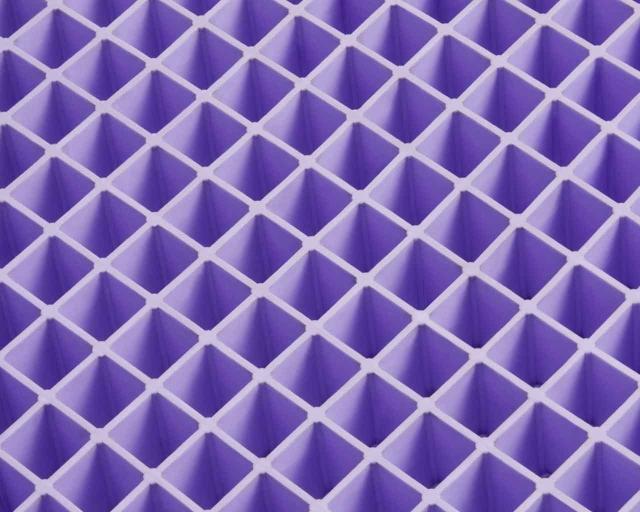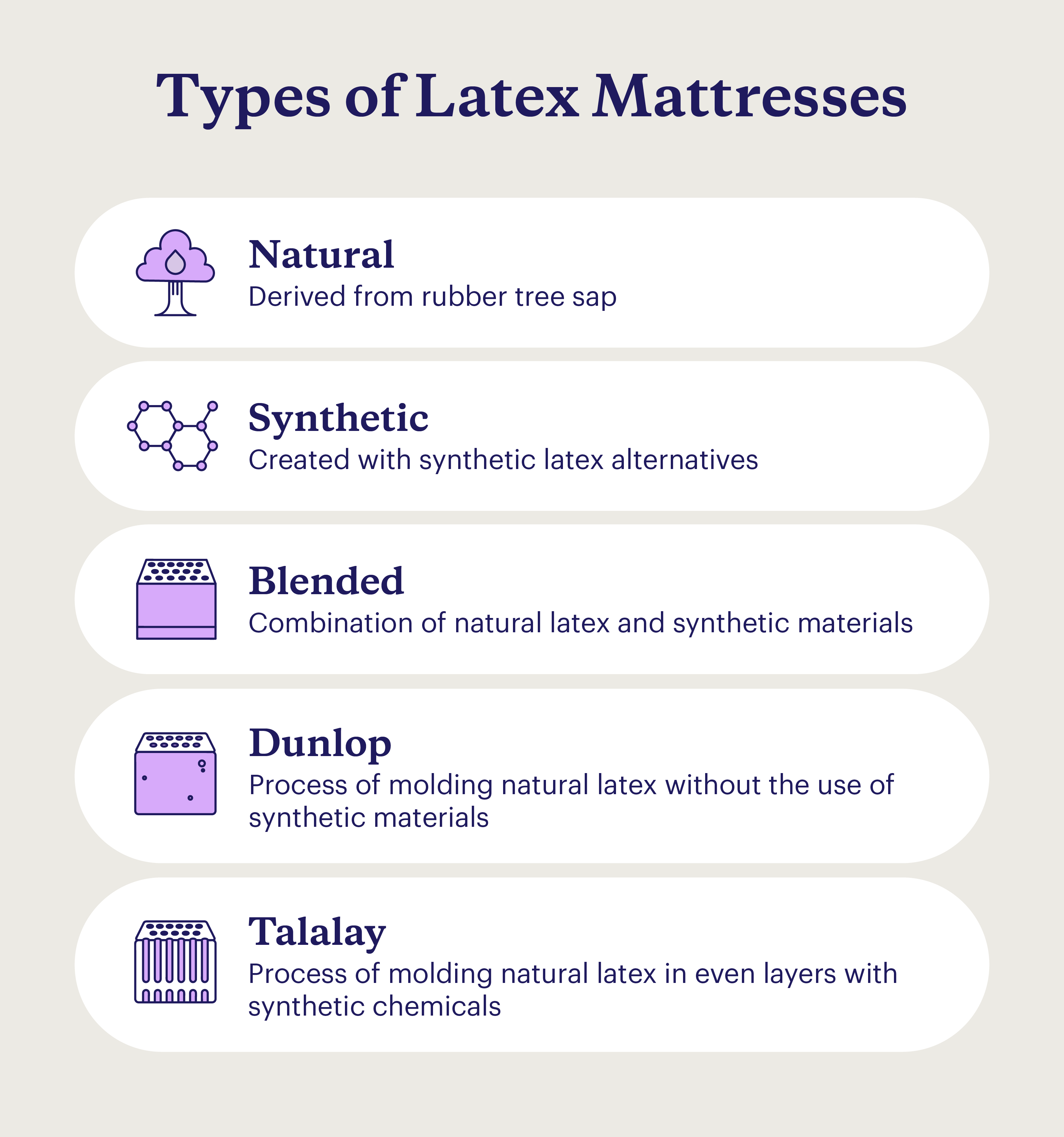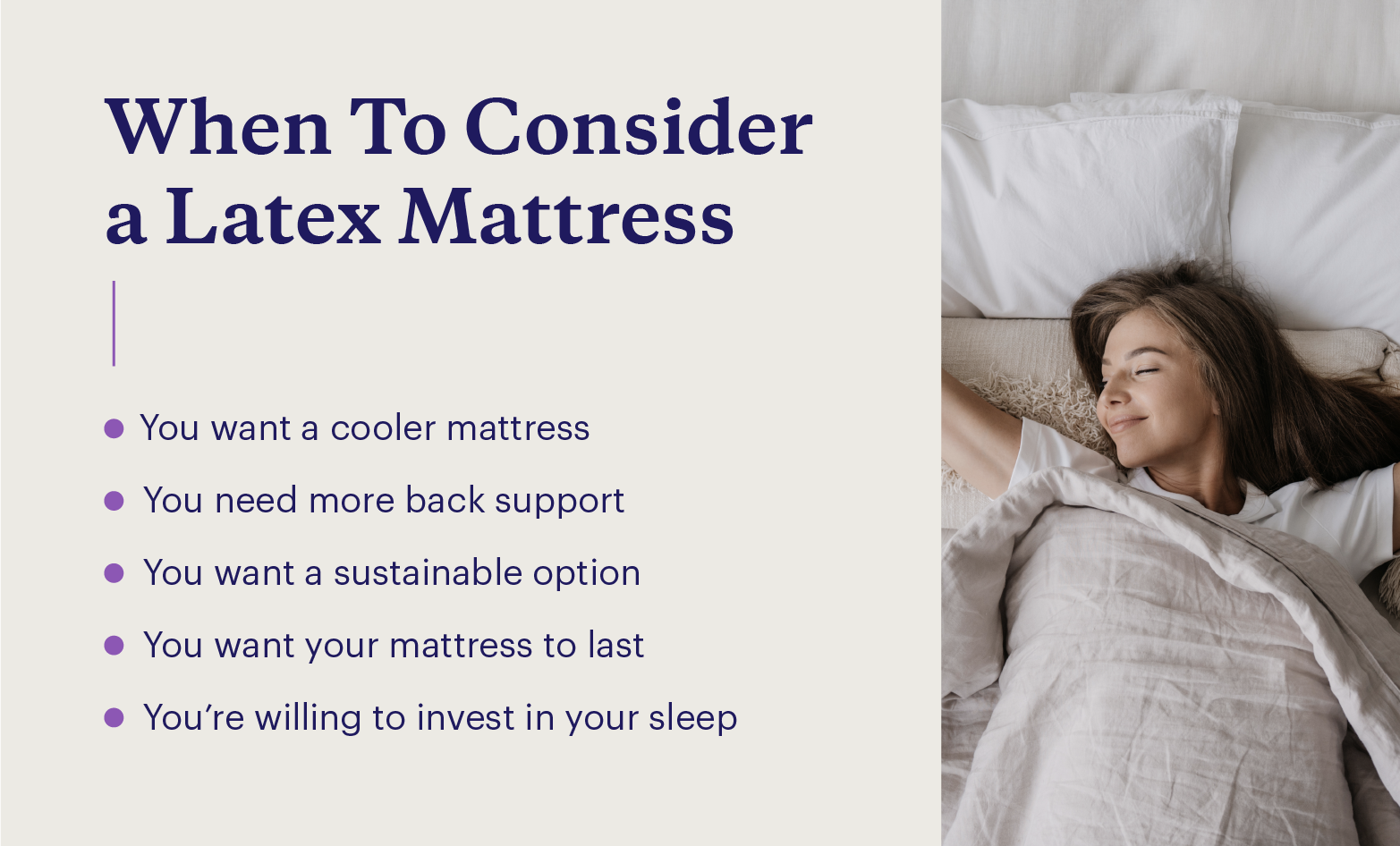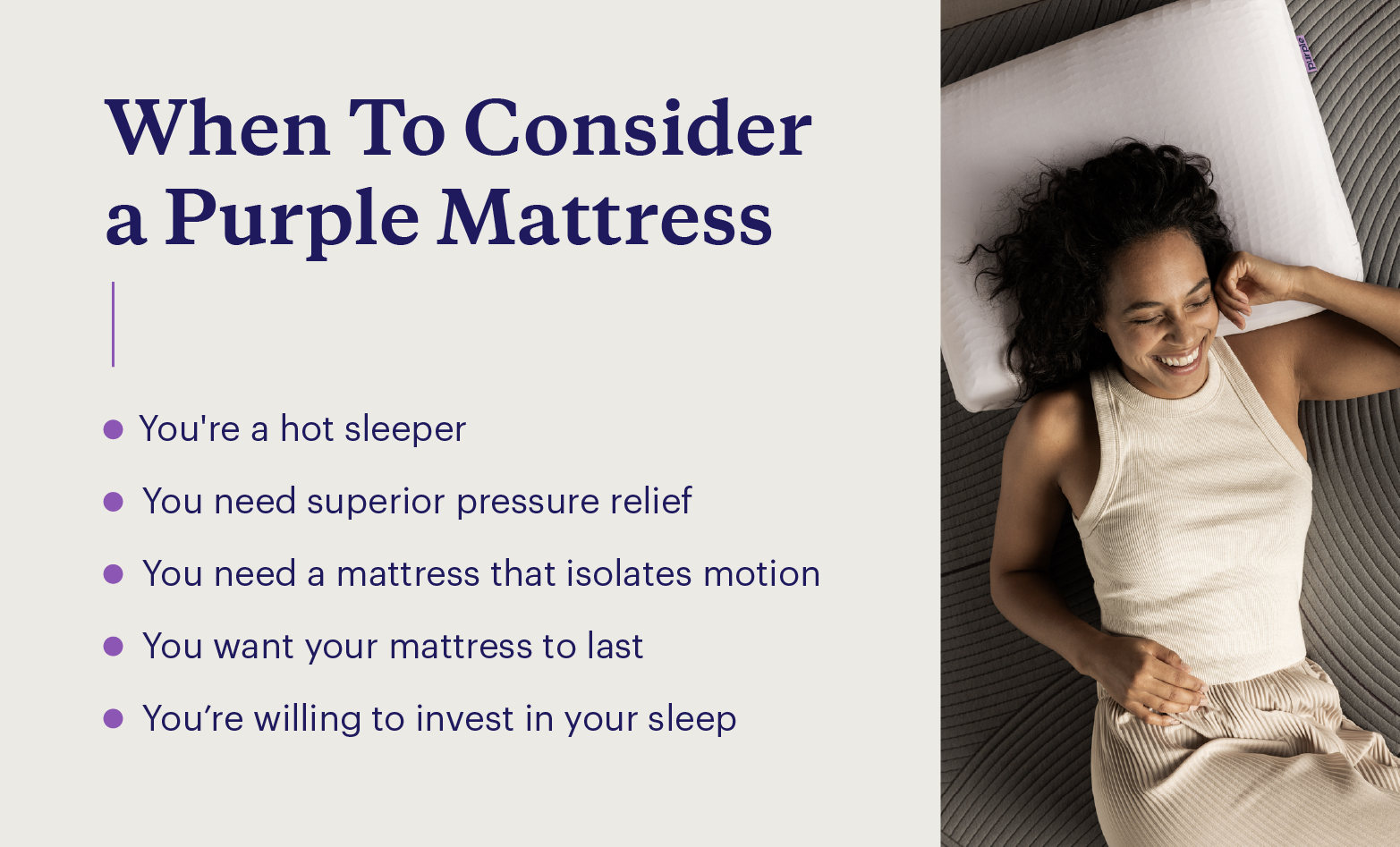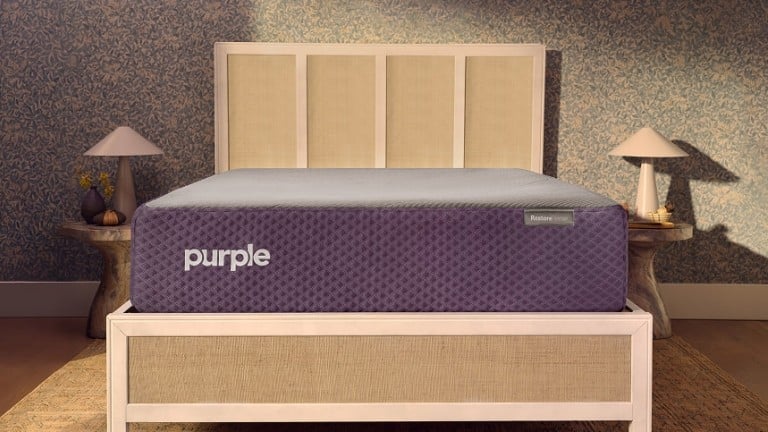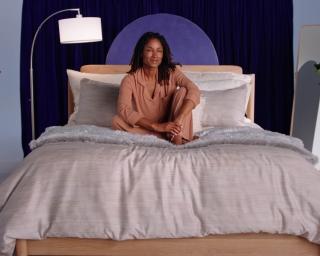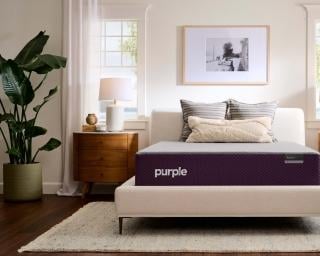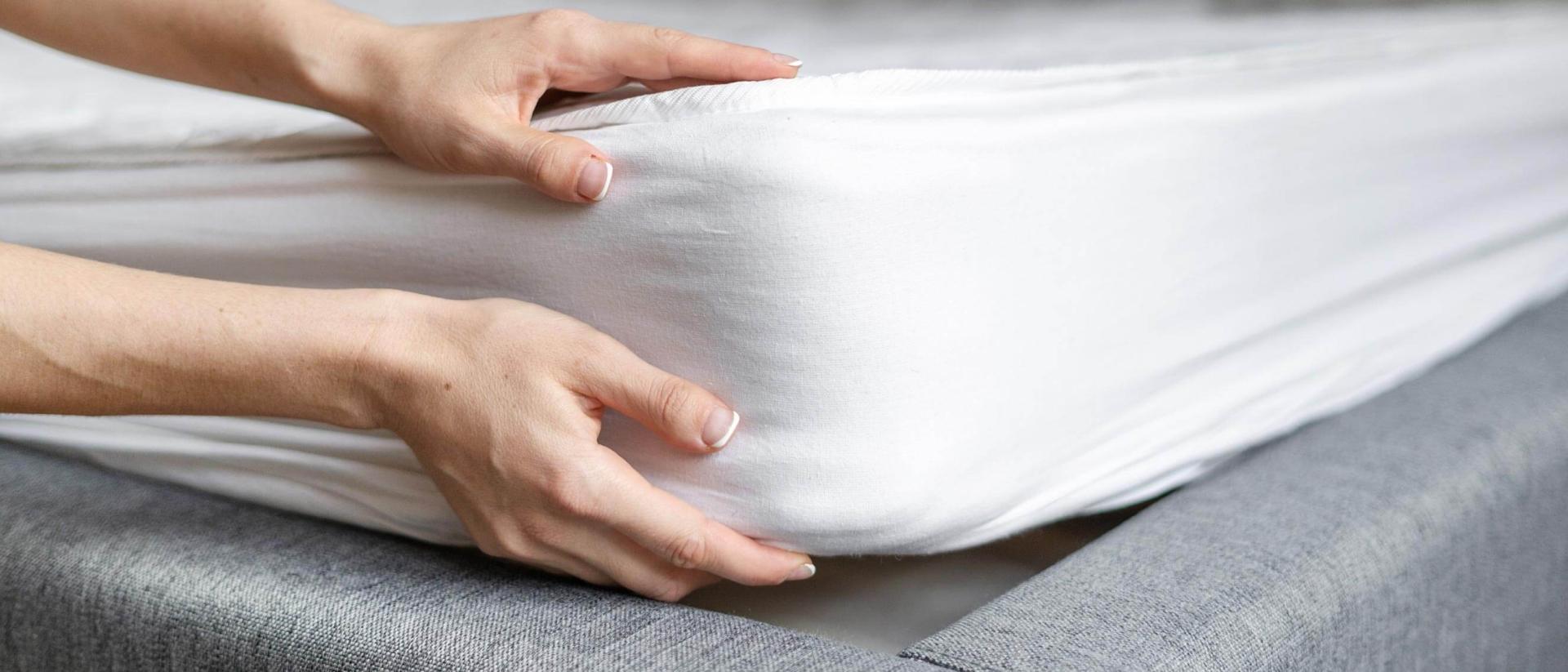
What Is a Latex Mattress? Comprehensive Guide [2025]
What is a latex mattress?
Latex mattresses feature layers of natural, synthetic, or blended latex for a bouncy, breathable feel. These mattresses are cooling, durable, and responsive, providing pressure point relief and support for most sleepers
Latex is a form of natural rubber that’s often used for products like disposable gloves, balloons, and rubber bands. But what is a latex mattress?
Latex mattresses feature latex that is whipped into foam, poured into a mold, and hardened into a buoyant, breathable material. Some latex mattresses are constructed with layers of latex while others may include memory foam layers or a hybrid coil structure.
In this guide, we’ll break down everything you need to know about latex mattresses, including pros and cons as well as how latex compares to other types of mattresses.
What Is a Latex Mattress?
Both natural and synthetic latex can be used in latex mattresses. Natural latex is derived from rubber tree sap which is then whipped into foam, while synthetic latex uses rubber substitutes like butadiene and styrene to achieve a similar airy, responsive feel.
When solidified, latex mattresses typically have a comparable consistency to memory foam, but latex is denser, bouncier, and more durable than most polyfoam mattresses. Latex mattresses don’t contour to your body as much as foam mattresses, but they offer better airflow, making them a better option for those who sleep hot.
Latex pillows provide the same bouncy, cushioning feel, making them ideal for cool, springy support through the head and neck.
If you’re looking for a breathable, durable mattress that keeps you cool and comfortable while you sleep, Purple mattresses provide the same benefits as a latex mattress so you can sleep well every night.
Types of Latex Mattresses
As you shop for mattresses online or in a showroom, you may see different terms referring to types of latex mattresses. The most common types you’ll encounter include:
- Natural latex: Natural latex comes from the milky white sap of the rubber tree, which originates from the Amazon basin and is cultivated around the world. Tapping rubber trees is often a harmless process, and trees can produce sap for decades, making all-natural latex a fairly sustainable material.
- Synthetic latex: Made with chemical alternatives, synthetic latex mimics the texture and feel of a natural latex mattress. Synthetic mattresses may be more affordable and may not affect those with latex allergies, but they’re often less durable than natural latex options.
- Blended latex: One of the most common types of latex is blended, which includes both natural and synthetic latex. Blended latex is often more affordable than natural latex and contains fewer chemicals than synthetic options. Talalay latex is one of the most well-known varieties of blended latex.
- Dunlop latex: The Dunlop method uses natural latex, but rather than layers of latex, the Dunlop method fills the mold at once without any synthetic fillers.
- Talalay latex: Using natural latex as a base, Talalay is a process used to form mattresses in which latex is poured into a mold in layers without filling it completely, then vacuum-sealed so the latex expands before being frozen and baked.
The Talalay process creates a more even texture throughout the mattress, but because it requires the use of chemicals and fillers to achieve its soft, springy feel, Talalay is never 100% natural latex.
On the other hand, the Dunlop process is simpler, more efficient, and often uses 100% natural latex. But Dunlop latex mattresses may have texture inconsistencies — with softer foam at the top and denser foam at the bottom — resulting from the pouring process.
Pros and Cons of Latex Mattresses
While latex mattresses are a great choice for hot sleepers who want a more responsive bed, they are not ideal for everyone, especially if you prefer a more contoured feel or have a lower budget.
Before you invest in a latex mattress, consider the advantages and disadvantages to help you determine if this type of mattress is a good fit.
Pros | Cons |
| Breathable and cooling | Not suitable for people with latex allergies |
| Responsive and bouncy | May be heavy and dense |
| Flexible and well-suited for adjustable bases | Unique mattress feel may not be comfortable for everyone |
| Durable construction | Less motion isolation than other beds |
| Natural latex can be eco-friendly | Fewer options and limited availability |
| Can be hypoallergenic | Often comes with a higher price tag than memory foam mattresses |
Pros
Bouncy, cooling, and long-lasting, latex mattresses offer a number of features that may promote better sleep quality.
Some of the top latex mattress benefits include:
- Breathability: Latex mattresses feature pin holes formed when the latex is whipped into foam. These holes allow better airflow so latex mattresses don’t trap heat, keeping sleepers cool overnight.
- Responsive Feel: Though latex mattresses won’t cradle your body as much as other materials, they are responsive and bouncy, providing plenty of pressure relief for most sleepers. The responsiveness also enhances ease of movement for sleepers who tend to toss and turn.
- Flexibility: Latex mattresses are often more flexible than other materials, so they’re compatible with adjustable bases and won’t warp or sag as easily as other beds.
- Durability: With proper care, latex mattresses can last upwards of 15 years. Generally, latex mattresses are more durable and last longer than other mattress materials, though the quality of the mattress and other factors can affect how long a mattress lasts.
- Can be eco-friendly: Natural latex is a relatively sustainable material. After it’s harmlessly collected as sap from rubber trees, it can be produced without the use of added chemicals. Some latex mattresses include synthetic materials, so if you’re looking for an eco-friendly mattress, make sure to check the label.
- Can be hypoallergenic: Mattresses made with natural latex may repel common allergens like dust mites and mold. Synthetic latex mattresses do not have the same hypoallergenic qualities, so if you’re looking for a latex mattress for allergy symptom relief, make sure you choose a mattress made with natural latex.
Cons
While latex mattresses are a good choice for some sleepers, there are several potential downsides to consider, including mattress weight, availability, and cost.
Common latex mattress problems may include:
- Allergies: People with latex allergies should avoid sleeping on a latex mattress. If your allergies are mild, you can try a synthetic latex mattress or use a mattress topper so your skin doesn’t make contact with the latex.
- Heavy: Latex is dense and heavy, so latex mattresses tend to weigh significantly more than other mattresses. You may have more trouble moving or adjusting a latex mattress, and if you order one online, you may need to pay extra for white-glove delivery and setup.
- Unique feel may not work for all sleepers: Latex is a unique material that may feel too firm and bouncy for sleepers who are used to other mattress types. Latex mattresses will soften over time, but they don’t provide the same contouring pressure point relief as memory foam mattresses and lack the sturdy support of an innerspring bed.
- Less motion isolation: Latex mattresses are often bouncier and more responsive than other mattress types, which can lead to poor motion isolation. If your partner moves around at night, you may feel it more on a latex mattress than on another type.
- Limited options: Latex is not as commonly used in mattresses as other materials like memory foam, and fewer companies offer latex mattresses. You may have fewer options to choose from and may not be able to shop around as much for a latex mattress that fits your needs and budget.
- Higher price tag: Latex mattresses often come at a higher price point than other mattress materials. A blended or synthetic latex mattress may be more affordable. You can also use a latex mattress topper for a similar feel.
Are you interested in the benefits of a latex mattress but aren’t sure if it’s right for you? The Purple RejuvenatePremier™ mattress uses breathable Talalay latex along with our GelFlex® Grid Plus and other comfort features to maximize your comfort and ensure you get the full-body support and pressure relief you need to sleep well.
Latex vs. Other Types of Mattresses
Before you invest in a latex mattress, compare the benefits and considerations of other mattress types so you can make the best decision for your specific needs and preferences.
Memory Foam
Latex and memory foam are both softer materials that provide pressure relief and support the whole body, but if you’re comparing latex vs. memory foam mattresses, consider the following factors to help you decide what's best for you.
- Feel: Memory foam contours to your body, and you may feel like you’re sinking into the mattress. Latex is bouncier and more responsive but still provides pressure point relief — though not as much as memory foam.
- Firmness: Most latex mattresses are firmer than memory foam mattresses, especially at first, so a latex bed may be better if you’re looking for more full-body support.
- Breathability: Memory foam mattresses tend to trap heat while latex features an open-cell structure that promotes airflow, keeping sleepers cool.
- Motion isolation: Because latex is a more responsive material, it transfers motion more readily than memory foam, which may be disruptive if you sleep with a restless partner.
- Durability: Latex mattresses tend to last longer than memory foam mattresses, though durability depends on additional factors such as material quality, construction, and manufacturer.
- Cost: Memory foam mattresses start at a much lower price point with a larger range of prices depending on quality and manufacturer. Latex mattresses are generally more expensive, especially if they are made with 100% natural latex.
Innerspring
Innerspring mattresses are often more affordable while latex mattresses tend to start at a higher price point. The quality, comfort, and support provided by each mattress type vary just as much as the average cost.
On an innerspring mattress, you may feel more supported because of the inner coil structure, but these mattresses can be noisy and may not last as long as a latex mattress. In general, latex beds are quieter, cooler, and more durable than most innerspring mattresses.
Hybrid
Both hybrid and latex mattresses provide support and pressure point relief, but natural latex mattresses tend to be more of an investment. Hybrid mattresses blend the features of innerspring and memory foam or latex mattresses, offering structured support with inner coils and contoured comfort from the outer layers.
Latex mattresses may last longer than some hybrid mattresses. Hybrid mattresses may be more prone to sagging due to the risk of broken coils, which can damage the integrity of the mattress and impact your sleep quality.
Some latex mattresses are latex hybrid mattresses, blending the added support of a hybrid mattress with the breathable, responsive, and durable qualities of latex. Purple’s RestorePremier™ hybrid mattress is a great example of this, blending the adaptive, contoured support of our GelFlex® Grid with the bouncy feel of a hybrid mattress for an unparalleled sleep experience.
Who Should Get a Latex Mattress?
How to choose a mattress ultimately depends on your personal preferences and the kind of support, feel, and features you need to sleep comfortably. Latex mattresses may be worth considering if any of the following apply to you.
- You tend to sleep hot: Latex mattresses often allow more airflow than other mattresses, helping you stay cool overnight.
- You’re a side, back, or combination sleeper: The firmness of a latex mattress may promote spinal alignment in these positions, and the responsive material makes shifting easier if you move around a lot.
- You’re looking for an eco-friendly option: Mattresses made with 100% natural latex are a more sustainable option than mattresses made with synthetic materials.
- You want a mattress that will last a long time: Latex mattresses may last over a decade with proper care.
- You’re willing to invest more to improve your sleep quality: You’ll likely pay more upfront for a latex mattress, but its durability may make your investment worthwhile.
Consider Purple Mattresses for Elevated Sleep
Latex mattresses are a great option if you’re looking for a durable, supportive, and breathable mattress, but the high price point, weight, and motion transfer are downsides worth considering.
The Purple RejuvenatePremier™ features airy, responsive Talalay latex enhanced with additional comfort and support features for a sleep experience unlike any other. All Purple mattresses feature our proprietary GelFlex® Grid, an innovative sleep surface that adapts to your body as you move, providing targeted pressure point relief and keeping you cool, as well as unique features like Edge-to-Edge Coils and Comfort Foam.
Whether you’re searching for a mattress that won’t make you sweat or you want a bed that cradles your joints, there’s a Purple mattress for you. Take advantage of our 100-night risk-free sleep trial or try out a Purple mattress in a store near you to see how it compares.
FAQ
In most cases, it is perfectly safe to sleep on latex. Latex mattresses offer support and pressure point relief with a bouncy, responsive feel that makes them comfortable for a range of sleepers depending on personal preference. Some latex mattresses use synthetic materials rather than all-natural latex, so if you’re looking for a sustainable option, check the type of latex used.
For sleepers with latex allergies who want to know whether latex mattresses are safe, the answer largely depends on how severe your allergies are and what type of latex is used in the mattress.
For mild allergies, you may be able to sleep on a latex mattress without any issues, especially if your bedding prevents your skin from directly touching the latex. You can also try a synthetic latex mattress that may not trigger an allergic reaction. If your allergies are more severe, it may be best to avoid latex mattresses altogether, but you should consult your doctor before making any decisions.
Most Purple mattresses do not contain any latex. Our GelFlex® Grid is a Hyper-Elastic Polymer that creates a supportive, responsive, and comfortable sleep surface that adapts to your body and keeps you cool —much like the positives of latex, without the negatives. For the best sleep experience, try the Purple RejuvenatePremier™ mattress, which features our High-Density GelFlex® Grid Plus, 5 Zone Edge-to-Edge Coils, a Quilted Euro Top, and breathable, airy Talalay latex for all the support and comfort you need.
If you’re interested in latex but aren’t ready to commit to a full mattress, try the Purple Harmony™ Pillow. This pillow features a durable, supportive Talalay latex core in addition to our honeycomb GelFlex® Grid, wrapped in a breathable cover to support your head and neck while also keeping you cool and comfortable. It’s the greatest pillow ever invented.TM
Latex mattresses are generally more durable and long-lasting than mattresses made from other materials, so they often take longer to break down and start sagging. If your latex mattress has started to break down, you can take steps to fix your sagging mattress like replacing your bed frame or foundation.
It’s also worth checking the mattress warranty to see if premature sagging is covered.
Latex mattresses are generally firmer than memory foam mattresses, but the firmness often depends on the type and thickness of latex and the process used to form the mattress.
Like other types of mattresses, latex mattresses are available in different firmness levels, so you can choose from options ranging from soft to firm depending on your needs. Weighing the pros and cons of a soft vs. firm mattress as well as the unique feel and benefits of latex can help you make an informed decision.
With proper use and care, latex mattresses can last between 10 and 15 years. Latex mattresses are generally more durable than other types of mattresses, so they’re often worth the investment.
No matter what kind of bed you have, if your mattress has started to sag, smells bad, or causes you pain, it may be time to replace your mattress.
More To Explore
Level up your sleep routine with our most-loved products.

